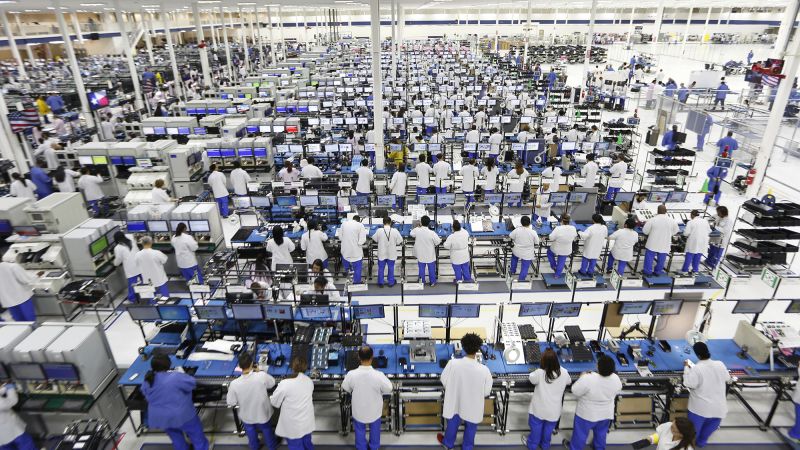In 2013, Motorola made a bold attempt to seize a larger slice of the competitive smartphone market, which was predominantly controlled by tech giants like Apple and Samsung. Their strategy centered on the tagline “Made in the USA,” which attempted to appeal to a growing segment of consumers who prioritized domestically produced goods. According to Dennis Woodside, the former CEO of Motorola and current CEO of Freshworks, the initiative resonated with customers. He recalled that many were inclined to consider products manufactured in the United States over foreign alternatives.
However, Motorola’s optimistic venture was short-lived. The following year, the company made the decision to shut down its Texas factory and consequently abandoned domestic assembly of its flagship phone, the Moto X, which was specifically designed to rival contemporaneous models such as the iPhone and Samsung Galaxy. Woodside’s experiences reflect a broader challenge faced by the tech industry where most devices, including smartphones, are primarily assembled in Asian and South American countries. This trend can be attributed to a multitude of factors, including the proximity to essential suppliers and lower labor costs. More critically, the United States faces a significant skills gap and a notable difficulty in filling factory positions, which complicates any attempt to shift smartphone production back to American soil.
Motorola’s predicament from over a decade ago has resurfaced in contemporary discussions, particularly as political pressures mount in the U.S. President Donald Trump has been vocal in urging companies like Apple and Samsung to produce their devices domestically, threatening tariffs on imports from regions like China—where much of the smartphone assembly takes place. With the looming possibility of higher tariffs, which were set to take effect, companies faced a decision: adapt or contend with increased costs. Compounding matters, India has now emerged as a leading exporter of smartphones to the U.S. but would also face tariffs.
Reflecting on these challenges, Woodside has conveyed warnings to current tech companies contemplating U.S.-based smartphone manufacturing. He emphasized the significant difficulty in sourcing skilled workers, advising that companies should not underestimate the complexities involved in both finding and retaining talent. He noted, “You have to have a very strong value proposition to the employee,” highlighting the importance for employers to create attractive working conditions that foster employee commitment.
Motorola’s ambitious effort to manufacture the Moto X in Fort Worth, Texas was partly aimed at providing consumers with customization options incompatible with products from competitors like Apple. Consumers could personalize the phone’s design through Motorola’s website—selecting colors for various components, thereby positioning the Moto X as a unique offering. Despite assembling the Moto X in Texas, key components were still sourced from Asia, indicating the intricate landscape of global manufacturing dependencies.
Despite these attempts, the sales of the Moto X fell significantly short of expectations. By the third quarter of 2013, industry analysts reported dismal sales figures, leading Motorola to ultimately announce the closure of its Texas factory and a shift in production strategy. Woodside acknowledged the financial burdens associated with U.S. production, as well as the fragmented nature of the supply chain, both of which contributed to the challenges faced by the company.
The unique obstacles experienced by Motorola during its U.S. manufacturing endeavors are emblematic of a larger pattern within the American manufacturing sector, which has struggled to compete with countries where labor is abundant and manufacturing robust. Notably, recent statistics indicated that the U.S. manufacturing sector faced significant job losses, with a decrease of 11,000 jobs reported between June and July.
Amidst these pressures, the issue of workforce readiness looms large. Surveys have indicated that many Americans are not drawn to factory work, complicating recruitment efforts for manufacturers in the U.S. This contrasts sharply with the situation in China, where a vast supply of labor pools supports the booming manufacturing industry, with numerous individuals employed in tech and electronic component assembly.
While tech executives, including Apple’s Tim Cook, have praised the Chinese workforce for its blend of skills, robotics, and technology expertise, the U.S. faces significant challenges in developing a similarly skilled workforce. The disparity in training systems and educational provisions further exacerbates the difficulties. Experts point out that American technical education varies widely, resulting in inconsistencies in the availability of skilled workers needed for advanced manufacturing roles.
The journey to revamping American manufacturing, particularly for electronics like smartphones, necessitates a substantial reconsideration of labor force training and education. As the technological landscape evolves with increasing automation and the rise of artificial intelligence, fresh skillsets—particularly in coding and data analytics—will become essential. Companies contemplating U.S. production must genuinely assess the feasibility of sourcing appropriately skilled labor. Woodside’s experience remains a cautionary tale, emphasizing the vital importance of understanding the complex nature of manufacturing and the workforce requirements specific to developing modern electronic products.











